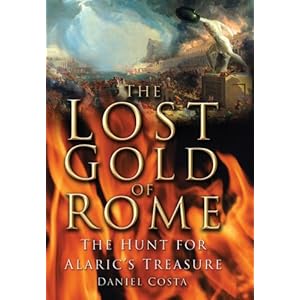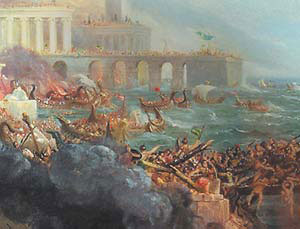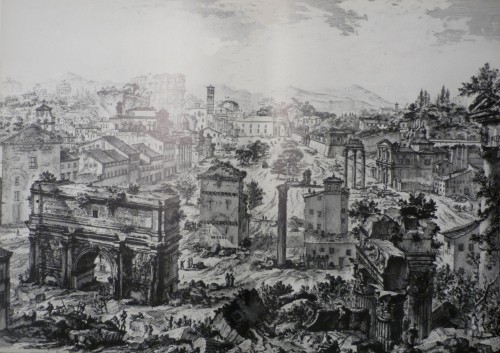The Lost Gold of Rome: The Hunt for Alaric’s Treasure ( 2007) by Daniel Costa
Rating: 




In AD 410, Rome suffered a catastrophe of unprecedented proportions when a foreign army led by the Visigoth king Alaric sacked the city and carried off its most valuable treasures.
This was the first time in 800 years, during which time Rome itself had accumulated the wealth of Empire. Alaric played a significant role in the dismemberment of the Roman Empire in the west, but he died before he could leave the Italian peninsula. His followers buried him in a secret tomb allegedly laden with the plunder of Rome that may have included the Jerusalem Temple treasures of the Jews, deposited in the so-called ‘Temple of Peace’. Daniel Costa’s account traces the life and death of Alaric and explores the modern quests to discover his grave, including the efforts of the Nazi Heinrich Himmler. Despite the likelihood that the grave has now finally been found, no definitive excavation has taken place..
Treasure-hunting expeditions, as well as the search for long-lost archaeological sites, are guaranteed to fascinate. One of the most intriguing, and elusive, is the unknown fate of the real Ark of the Covenant, but also the Great Menorah and the other treasures liberated from the Herodian Temple in Jerusalem by Roman general Titus, and brought back to Rome after AD 70. But the Temple artefacts are only part of what may have disappeared from Rome during a period of only a few days in August 410 when Alaric’s Visigoths ransacked the city. Alaric himself died suddenly not long afterward, near the town of Cosenza, Calabria, and was buried secretly, supposedly under a river bed. The book makes a case for speculating some of the fabulous treasures of Rome were buried with Alaric, mainly by examining historical Visigoth custom.
From this basic premise, the book recounts from the standard historical works the decline of Rome, the rise of Christianity, the takeover in the West by the Germanic tribes, later depredations upon St. Peter’s by Muslim raiders and the consequent scattering of the churches holy relics. The chapters on early imperial Rome describe Constantine’s “heroic” support of Christianity and repeat the story of his supposed vision of the cross, following up with a detailed account of the churches he built and endowed, and whose riches Alaric later removed.
The Magnificence of the Visigoths’ Roman Booty
(from Chapter 5: The Sack of Rome)
As Emperor Honorius wasted valuable time… the Visigoths carried out one of the greatest looting operations in the history of the world. Even a partial list of the unbelievable gifts of Constantine the Great to the Basilica of St John in Lateran, as provided by the Book of Pontiffs, shows just how rich the Visigothic booty must have been:
A 2,025lb silver fastigium (a sort of canopy) of hammered burnished silver with a vault of the finest gold;
At the front of the fastigium, a 5ft, 120lb figure of the Saviour seated on a chair and 12 Apostles, each 5ft high and weighing 90lb with crowns of the finest silver;
At the back of the fastigium, a Saviour seated on a throne, 5ft high, of the finest silver weighing 140lb, and 4 spear-carrying angels, each 5ft tall and weighing 105lb, also of the finest silver, with Alabanda jewels (red or purple almandine from Asia) in their eyes;
Hanging beneath the fastigium, a light of the finest gold embellished with 50 dolphins of the finest gold, 50lb each, with chains weighing 25lb each; 4 crowns of the finest gold with 20 dolphins, each weighing 15lb;
The apse vault of the basilica, of gold foil in both directions, 500lb; 7 gold patens (plate for the Eucharist bread), 30lb each; 7 scyphi (drinking vessels or goblets) of the finest gold, 10lb each;
A special scyphus of hard coral, adorned on all sides with prase (a light-green, translucent variety of chalcedony) and jacinth (an ancient gem believed to be amethyst or sapphire);
Jewels, inlaid with gold, total weight 20lb 3oz; 2 amae of the finest gold, 50lb each; 40 smaller chalices of the finest gold, 1lb each.
The Book of Pontiffs provides evidence that the Visigoths looted the gold and silver furnishings of the Christian churches. Thus, it mentions that in the time of Pope Sixtus (Xystus) III (432–40), Emperor Valentinian replaced the heavy silver fastigium of the Lateran basilica that ‘had been removed by the barbarians’. Earlier, Pope Celestine (422–32) is recorded as having endowed the Basilicas of Sts. Peter and Paul with silver furnishings ‘after the Gothic conflagration’.
Of course, the Visigoths raided the neighbouring Baptistery (Battistero), in which the porphyry Holy Font was covered inside and out with 3,003lb of finest silver. At its centre, there was a porphyry column supporting a golden basin containing a 52lb golden candle in which 200lb of balsam were burnt at Eastertide. A 30lb gold lamb, from which water poured, stood on the rim of the font between a 170lb, 5ft silver Saviour and a 100lb, 5ft silver St John the Baptist. There were seven, 80lb silver stags pouring water. Finally, there was a 15lb gold censer (a container for burning incense) encrusted with 42 parse and jacinth jewels. Such magnificent treasures were, undoubtedly, beyond the wildest dreams of any barbarian plunderer.
The loot of the Visigoths has been described as, quite literally, ‘incredible’. The opulence of the Visigothic booty from Rome and Italy is attested to by the gifts which Galla Placidia received from Athaulf, Alaric’s successor, when he married her in January 414, in Narbonne, in what is now southern France.
Obviously, these gifts represented only a small fraction of the Visigothic loot from Rome and Italy. Basing his writing on Olympiodorus’ account, Gibbon mentions that Galla Placidia received from Athaulf fifty basins filled with gold coins, and fifty basins loaded with precious stones of incalculable worth.
Many treasures that were hidden only to be abandoned by the fleeing Romans remain lost forever. Stories of gold and jewels concealed in parks or houses persisted for a long time after the sack, but none were recovered.
The fall of Rome, the eternal city of the empire and the very symbol of law and civilisation, also traumatized the numerous citizens in the provinces of the empire. In remote Jerusalem, Catholic scholar Jerome lamented: “My voice sticks in my throat, and, as I dictate, sobs choke my utterance. The city which had taken the whole world has itself been taken.” The sack of Rome, the downfall of a city that had for long been considered the centre of the civilised world, was a powerful symbol of the end of antiquity and the beginning of the Dark Ages.

After three long days, in the manner of their third-century ancestors, Alaric and his people left Rome and marched on to Campania. The Visigoths did not leave occupying forces in Rome. They did not make changes to the local government, either. Although the damage caused by the barbarians was considerable, much of the structure of Rome remained intact. In the end, we may never know what happened to the plundered treasure. It may be recovered someday, as other gold and silver from this period has been. There is much speculation as to whether the Visigoths took it west with them to France. Personally, I believe it was most likely broken up and melted down, perhaps even making up a portion of the reserves we hoard under our banks.
The book God’s Gold: The Quest for the Lost Temple Treasure of Jerusalem by Sean Kingsley should be considered by readers of ‘The Lost Gold of Rome’ (To be reviewed).